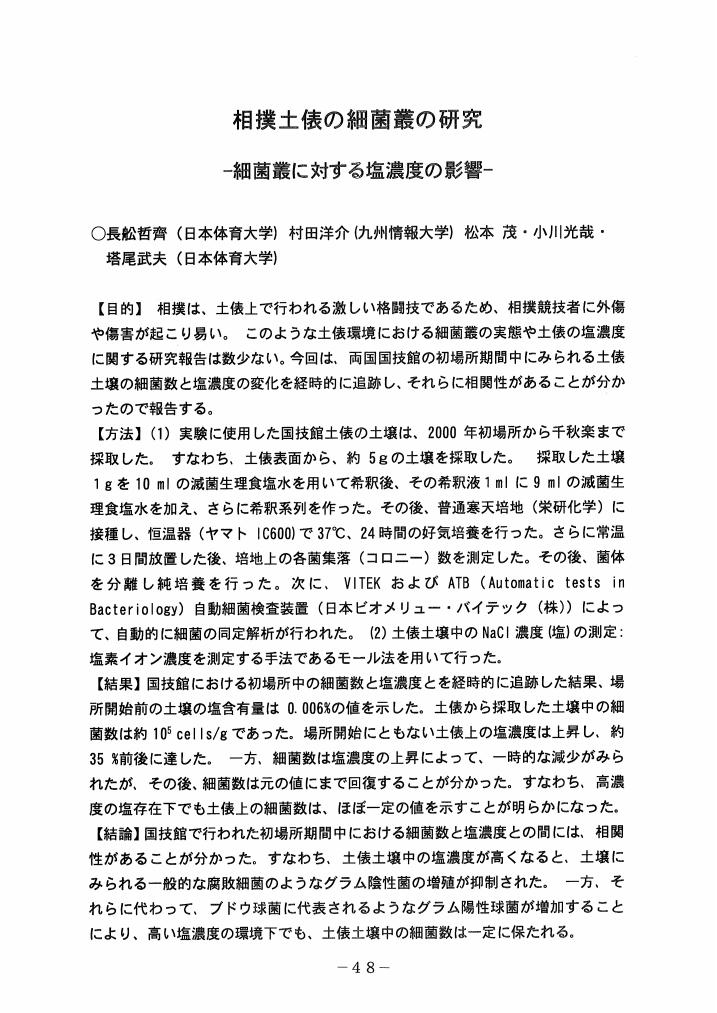4 0 0 0 OA 相撲土俵土壌の細菌叢の研究: 破傷風菌の分離同定
- 著者
- 三星 暢公 長舩 哲齊 Harvard LYMAN 松本 茂 小川 光哉 塔尾 武夫
- 出版者
- 日本武道学会
- 雑誌
- 武道学研究 (ISSN:02879700)
- 巻号頁・発行日
- vol.34, no.2, pp.31-39, 2001-11-30 (Released:2012-11-27)
- 参考文献数
- 23
The bacterial flora of the dohyo (sumo ring) has received little attention. If the flora are identified then treatment or prevention of any bacteriallesions or infections incurred by the wrestlers is possible. In the present study, using the automatic identification kit, the VITEK Auto Microbic System or Automatic Tests in Bacteriology, we describe the bacterial flora found in the dohyo over the four seasons of the year. Anaerobic bacteria, such as Clostridium tetani, were found, a possible source of serious infection. The exotoxin formed by Clostridium tetani, the causative agent of lockjaw tetanic spasm, is also neurotoxin. Nippon Sport Science University's dohyo is not a possible. source of infection by the spores of Clostridium tetani as the dohyo in the University is well maintained.
1 0 0 0 OA 相撲土俵の細菌叢の研究 ―細菌叢に対する塩濃度の影響―
1 0 0 0 OA 80D70904 教育環境における細菌学的調査 : 土俵土壌の細菌叢
- 著者
- 三星 暢公 田中 和幸 長舩 哲齊 松本 茂 小川 光哉 塔尾 武夫
- 出版者
- 一般社団法人 日本体育学会
- 雑誌
- 日本体育学会大会号 第50回(1999) (ISSN:24330183)
- 巻号頁・発行日
- pp.635, 1999-09-15 (Released:2017-08-25)
1 0 0 0 OA 剣道防具「面」由来ブドウ球菌に関する研究
1 0 0 0 IR スポーツ競技施設の細菌の分離同定(II) : 塩濃度と細菌叢に関する基礎的研究
1 0 0 0 OA スポーツ競技施設の細菌叢の基礎的研究 : 紫外線によるレスリング場の細菌汚染の制御
1 0 0 0 OA 自動細菌同定装置を応用した剣道具の細菌叢の研究:「面」に由来する細菌の分離同定
- 著者
- 田中 和幸 長舩 哲齊 袴田 大蔵 志沢 邦夫 伊藤 孝
- 出版者
- 日本武道学会
- 雑誌
- 武道学研究 (ISSN:02879700)
- 巻号頁・発行日
- vol.34, no.1, pp.23-33, 2001-07-31 (Released:2012-11-27)
- 参考文献数
- 37
The bacterial flora of the Men of Kendo (the fencer wears a helmet and mask in the Japanese fencing)has received little attention. Bacteriological examinations were carried out to get information about bacteria on the Men of Kendo in the Nippon Sport Science University during the four seasons. Forty five strains of typical bacteria istlated from the Men of Kendo were rapidly identified with a Gram-Positive and Negative Identification card used in conjunction with the Auto Microbic system. The isolates were distributed in the 17 genera, Bacillus, Flavimonas, Chryseomonas, Actinobacillus, Stenotrophomonas, Corynebacterium, Comamonas, Flavobacterium, Micrococcus, Pasteurella, Pantoea, Pseudomonas, Vibrio, Eikenella, Sphingobacterium, Staphylococcus and Acinetobactor. We found that these bacteria were non-pathogenic bacteria which are often found on the Men of Kendo. Its main constituent were Staphylococcus saprophyticus and Micrococcus luteus, which were followed by Bacillus sphaericus. Results obtained in the successive isolation trials showed that Micrococcus luteus as in figure 1 is typical bacteria of the Men during the four seasons. However, Staphylococcus epidermidis, Staphylococcus capitis, Staphylococcus hominis, Staphylococcus haemolyticus, Pseudomonas stutzri, Bacillus subtilis and Bacillus cereus strains have recently been noticed as the bacteria of opportunistic infections in the clinical medicine.
1 0 0 0 ユ-グレス葉緑体形成の初期過程における構成酵素の局在性
Euglena細胞は前培養条件を適切に選べば、葉緑体形成の初期暗過程が観察できることを見いだし暗所で起こる現象と、光照射によって初めて誘導される現象とを区別して追究することを可能にした。本報告はこの実験系を用いて、葉緑体形成の初期にみられる光合成酵素RuBisCOおよび光化学系IIのLHCP IIの細胞内局在性を連続切片疫電顕法で経時的に追跡したものである。暗所で継代培養したEuglenaを有機栄養培地中で静置培養すると細胞質内にパラミロンと共に脂質の蓄積がみられる。このような細胞を暗所で無機培地に移しCO_2を通気する。144時間後の細胞に、照度3ftーcの弱光又は強光150ftーcを照射した。弱光条件下で形成されたチラコイド膜は方向性を欠いたカ-リ-型になる。一方、強光条件下では48時間後にピレノイドが葉緑体の中央部に移動し、正常な葉緑体構造が完成された。免疫電顕法により、RuBisCOの細胞局在性を追跡するとRuBisCOは細胞核およびCOS構造、次いでプロピレノイド及びストロ-マに見られた。次に、弱光3ftーcを照射すると、従来の実験系においては弱光条件下では合成されないとされてきたLHCP IIの合成、照度3ftーcでも起こることが免疫電顕法により初めて確かめられた。すなわちLHCP IIは弱光照射2時間後、核およびCOS構造、その後ゴルジ体、次にプラスチドに観察された。その結果、細胞質で合成されたLHCP IIがゴルジ体を経由し、葉緑体に運ばれることを最初に見いだした。

